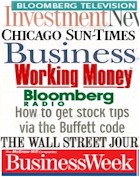Investor of the
Century—Warren or ... ?
John Price, Ph.D.
Who was the investor of the
century? To find out, the Carson group surveyed investment
professionals around the country. Based on 300 replies,
the popular choice was Warren Buffett followed closely by
Peter Lynch. Next came John Templeton of the Templeton Group.
Benjamin Graham and David Dodd, the founders of value investing,
and hedge fund guru George Soros made up the top five.
Buffett’s methods are deceptively simple.
Buy and hold (forever, if possible) companies with an economic
moat that are selling for less than their intrinsic value.
This Buffett explains is the present value of the cash that
can be taken out of the company over its remaining life.
The hard part is to forecast the cash-generating
potential, one reason why Buffett shuns technology: It’s
too hard to forecast. “I focus on absence of change,”
says Buffett, explaining why he prefers Wrigley’s,
say, to Microsoft. “I don’t think the Internet
is going to change how people chew gum.”
Stockholders in Berkshire Hathaway, the company
managed by Buffett, have recently paid a price for his avoidance
of technology: Currently the stock is at a two-year low.
This hurts when it is compared to its earlier record. For
example, up to mid 1998 the average annual return for Berkshire
Hathaway has been an outstanding 35 percent for the previous
20 years. Wow! And a double wow! when you compare it with
the return of the S&P500 index over the same period.
Just 12.9 percent.
Not that there is anything wrong with 12 or
13 percent over 20 years. (More about this later.) It is
just that it is not in the same league as 35 percent.
It hurts even more when you compare it with
indices that have more high tech and internet stocks in
them. For example, the NASDAQ index started 1999 at 1854.39
and ended at 3707.82, a gain of 99.7 percent.
Is Berkshire going to come back? I certainly
believe so. Call me old fashioned. But in the end aren’t
we buying a stock because we believe that it is going to
generate a profitable stream of cash in the future? And
I think that Berkshire has investments that will do just
this.
A lot of the market gain is on the back of
some rather strange statistics. Consider Amazon.com, one
of the stocks that has been a shining star up until the
end of 1998. I love shopping at Amazon. Great site. Easy
to use. Even more. Through the generosity of the company
(and stockholders) they are willing to subsidize my purchases.
During 1999, Amazon lost over a million dollars
per day, more than $2 per share. Put it another way. Over
the year, Amazon gained 11 million new customers so each
new customer cost the company over $100.
Anyway, that is enough of the mysteries of
current prices of some stocks. I want to end the article
by talking about other investors who I think should receive
awards. In fact, there is a whole family of them but I shall
only mention three: Donald, Sally and Nancy. They are Donald
Dow Jones, Sally S&P 500, and Nancy NASDAQ.
Over the past ten years they have averaged
15.1 percent, 15.5 percent, and 26 percent per year. Putting
aside the NASDAQ for the moment, averaging 15 percent for
ten years means your money has quadrupled over this time.
Investing $10,000 per year at this rate gives you a healthy
$233, 492 at the end of ten years.
The most important thing with index investing
is to keep doing it regularly. Even investing at the worst
time of the year or the best time of the year makes little
difference in the long run. This was clear from the figures
in my article “To Invest or not to Invest: That is
NOT the Question”. Click here for details.
There are now many mutual funds that you can
invest in which track each of the major indices. Also, if
you prefer more socially responsible companies, you can
invest in a fund that tracks the Domini 400 Social Index.
This index is similar to S&P500 consisting of 400 stocks
that pass social, environmental and ethical criteria.
Another statistic that is worth pondering
is that major indices outperform around three quarters of
all funds. So, if you are just getting started, putting
a slab of your funds with Donald, Sally, Nancy, or any of
their extended family in an index fund makes a lot of sense.
The same applies if you do not have the time or the inclination
to study the market.
As Buffett said in the 1993 annual report
of Berkshire Hathaway, “By periodically investing
in an index fund, the know-nothing investor can actually
out-perform most investment professionals.” And if
you want to move to being a know-something investor, keep
in mind the words of Josh Billings, “It is better
to know nothing than to know what ain’t so.”
|



